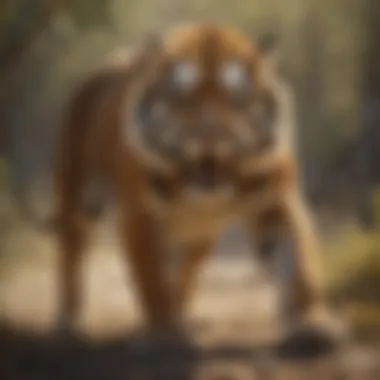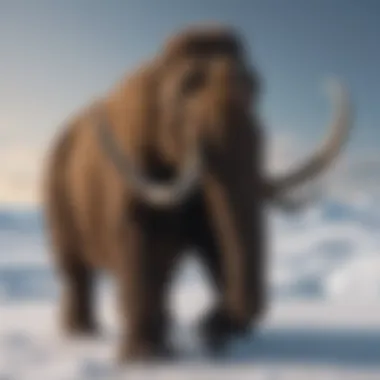Unveiling Ancient Predators: The Enigmatic World of Extinct Beasts of Prey


Rock and Fossil Identification
Diving into the realm of exploring extinct predators necessitates a keen eye for identifying significant rocks and fossils. Understanding the types of rocks and fossils embedded in the earth's history is paramount. By closely examining the characteristics of these remnants from the past, enthusiasts can piece together the puzzle of ancient beasts.
Uncovering fossils and rocks requires specialized tools tailored to the geological task at hand. By utilizing tools designed for identification purposes, collectors can enhance their findings and facilitate a deeper exploration into the world of extinct predators.
Collecting Tips and Techniques
Embarking on the enthralling journey of collecting fossils and rocks demands adherence to best practices. Implementing meticulous techniques while searching for prime collecting sites elevates the experience. Locating these prime sites involves understanding geological markers and clues left behind by ancient fauna.
The extraction process must be handled with utmost care. Safely extracting specimens ensures the preservation of these invaluable relics. By following established guidelines, collectors can contribute meaningfully to the body of knowledge surrounding extinct predators.
Preservation and Display
Preservation techniques play a vital role in maintaining the integrity of rocks and fossils. Employing methods that safeguard these artifacts ensures their long-term endurance. Proper storage methods, such as controlled environments and archival materials, serve to protect the specimens from elemental degradation.
Creative display ideas serve as a platform for enthusiasts to showcase their curated collection. Crafting innovative displays not only captivates audiences but also educates them on the significance of these ancient relics. Balancing preservation with public engagement is key in fostering a deeper appreciation for extinct predators.
Geological Insights
Delving into the geological aspects surrounding extinct predators unveils a tapestry of fascinating information. Understanding geological formations and processes sheds light on the environments these beasts inhabited. Exploring the historical significance of rocks and fossils enables enthusiasts to appreciate the intricate interplay between geology and paleontology.
Notable discoveries in the field of paleontology highlight the continuous evolution of our understanding of ancient predators. These discoveries serve as milestones in unraveling the mysteries of the past, pushing the boundaries of scientific knowledge. By immersing in geological insights, collectors can forge a deeper connection with the world of extinct predators.
Introduction to Extinct Predators
The fascinating realm of extinct predators stands at the core of this narrative, beckoning us to explore the enigmatic world where towering carnivores once reigned supreme. As we embark on this expedition through time, we peel back the layers of history to unveil the majestic beasts that prowled the ancient landscapes. These extinct predators, with their unrivaled prowess and cunning, offer us a captivating glimpse into the bygone eras of our planet's ecological tapestry. Within this section, we delve deep into the intricacies of extinct predators, illuminating their significance in shaping the evolutionary trajectory of life on Earth.
Defining Extinct Predators
The concept of extinct predators
Venturing into the concept of extinct predators, we confront a mirage of primal ferocity and primal splendor. The essence of these creatures echoes through the corridors of time, resonating with tales of predator-prey dynamics and ecological dominance. The allure of the concept lies in its ability to transport us to a realm where humankind coexisted with formidable hunters whose existence now lingers only in fossilized memories. By dissecting this concept, we unlock a portal to the past, shedding light on the intricate web of relationships that once governed the natural world. Read on as we unravel the allure and mystique surrounding these vanished predators, enriching our understanding of the earth’s dynamic history.


Significance in ecological history
The significance of extinct predators in ecological history reverberates through the ages, shaping the very fabric of our modern ecosystems. These apex predators wielded immense influence over their environments, sculpting the intricate balance of nature through their predatory prowess. By delving into their ecological roles, we unearth a treasure trove of insights into the delicate dance between hunters and the hunted. Understanding their significance not only lends depth to our perception of ancient ecosystems but also serves as a poignant reminder of the interconnectedness of all life forms on this planet. Join us as we navigate the annals of ecological history, venerating the legacy of these formidable predators that once roamed our planet.
Evolutionary Role of Predators
Impact on ecosystems
The evolutionary impact of predators on ecosystems unfolds as a paramount force, driving the pulse of life across varied landscapes. From the intricate tapestries of forests to the vast expanses of savannas, these predators shaped the very foundation of biodiversity through their predatory exploits. Their presence catalyzed a cascade of effects that reverberated through trophic levels, dictating the population dynamics of countless species. As we dissect their impact, we uncover a mosaic of ecological interactions that underscore the intricate web of life on Earth. Join us on this odyssey through time as we unravel the profound impact of predators on the ever-evolving tapestry of ecosystems.
Predator-prey dynamics
The intricate dance of predator-prey dynamics emerges as a cornerstone of ecological resilience, charting the ebb and flow of life throughout the annals of time. Within this dynamic interplay, predators and their prey forged a symbiotic relationship that shaped the evolutionary course of species across landscapes. By scrutinizing these dynamics, we delve into the relentless struggle for survival that defined ancient ecosystems, painting a vivid portrait of the primal forces that governed the natural world. Join us as we dissect the nuances of predator-prey interactions, unraveling a tapestry of intrigue and complexity that underpins the ecological legacy of our planet.
Majestic Megafauna
The Megafauna Era
Majestic Megafauna plays a crucial role in shaping the narrative of ancient predators. These gigantic creatures not only captivate the imagination with their sheer size but also provide valuable insights into prehistoric ecosystems and the dynamics of predator-prey relationships. By delving into the Megafauna era, we unravel a chapter of Earth's history dominated by colossal beasts that roamed the lands and seas.
Diverse Range of Giant Predators
The Megafauna era boasted a diverse range of giant predators, each adapted uniquely to its environment and hunting strategies. From towering mammoths to formidable saber-toothed cats, these predators held key positions in their respective food chains, influencing ecosystem structures significantly. Exploring the intricacies of these giant predators offers a glimpse into the evolutionary adaptations that enabled them to thrive in ancient landscapes.
Impact on Ecosystems
The colossal presence of Megafauna had profound impacts on ecosystems during their reign. As apex predators, they regulated the populations of other species, shaping biodiversity and ecosystem stability. Their roles in controlling herbivore populations, influencing vegetation patterns, and even modifying landscapes underscore the intricate interplay between predators and their environments. Understanding the repercussions of Megafauna on ecosystems provides essential context for comprehending past ecological dynamics and biodiversity patterns.
Notable Megafauna Predators
Unveiling the mysteries of the Megafauna era leads us to the remarkable predators that once ruled the Earth with supremacy.
Saber-Toothed Cats
Among the most iconic Megafauna predators were the saber-toothed cats, distinguished by their elongated canine teeth and powerful built. These feline predators utilized their saber teeth not just for killing prey but also for social displays and dominance within their species. The significance of saber-toothed cats in the Megafauna era exemplifies a predatory adaptation that played a pivotal role in predator-prey dynamics, influencing the evolutionary pathways of both predators and prey.


Giant Bears
Another notable presence in the Megafauna landscape was the giant bears, massive omnivores that thrived across various habitats. These towering beasts combined formidable strength with versatility in diet, allowing them to exploit a range of resources and adapt to changing environmental conditions. The evolutionary success of giant bears during the Megafauna era highlights their resilience and competitive edge in a world teeming with diverse predators and prey species.
Marine Predators of the Past
Marine Predators of the Past hold a crucial position in the intricate tapestry of ancient predators. These formidable creatures, adapted to the marine environment, offer unique insights into the evolution of predatory behaviors. Exploring the depths of the oceans, these ancient predators play a significant role in the ecological history of our planet. Their presence not only shaped marine ecosystems but also provides a window into the past world teeming with ferocious hunters and elusive prey. The study of marine predators of the past enriches our understanding of prehistoric life forms, illustrating the diverse array of predatory strategies that have existed throughout history.
Ancient Sea Monsters
Among the intriguing creatures of the ancient seas, Megalodon emerges as a standout predator. Despite its colossal size and fearsome reputation, Megalodon ruled the oceans with unparalleled supremacy. Its primary characteristic lay in its massive serrated teeth, capable of tearing through flesh with astonishing precision. In the context of this article, Megalodon serves as a compelling subject due to its prominence as one of the largest predators in marine history. The unique feature of Megalodon lies in its ability to adapt to a wide range of marine environments, showcasing exceptional versatility that contributed to its survival as a apex predator. While its immense size granted significant advantages in hunting, it's reduced mobility in shallower waters created limitations for its hunting grounds.
Ichthyosaurs
Another remarkable predator of the ancient seas, Ichthyosaurs, presents a fascinating case study in marine evolution. These sleek reptiles, resembling modern-day dolphins, seamlessly navigated the waters with their streamlined bodies and fins. Ichthyosaurs' key characteristic revolves around their efficient propulsion mechanisms, enabling them to swiftly chase down prey across vast marine expanses. Their inclusion in this article is paramount as they exemplify the incredible diversity of marine predators during prehistoric times. A unique feature of Ichthyosaurs was their viviparous reproduction, giving birth to live offspring rather than laying eggs, providing a competitive edge in sustaining their populations. This distinctive reproductive strategy contributed to their success in adapting to varying oceanic conditions and ecological niches.
Predatory Evolution in Oceans
Delving into the intricate realm of predatory evolution in oceans unveils a captivating saga of survival strategies and behavioral adaptations. The section on 'Adaptations for hunting' elucidates the specialized features developed by marine predators to secure their meals effectively. Highlighting the remarkable characteristics of these adaptive traits underscores the evolutionary arms race between predators and prey, shaping the dynamics of ancient marine ecosystems. The unique feature of these adaptations lies in their precision and efficiency, enabling predators to secure sustenance in challenging underwater environments. While these adaptations offer evolutionary advantages, they also present limitations in scenarios where environmental changes outpace the adaptive abilities of these predators.
Impact on marine ecosystems
The influence of marine predators on aquatic ecosystems is a pivotal aspect deserving of attention within the context of this article. Exploreing Their profound impact on food webs, population dynamics, and species interactions sheds light on the delicate balance within marine environments. The key characteristic of their influence lies in regulating prey populations, thus shaping the biodiversity levels within these ecosystems. This aspect is beneficial to this article as it underscores the integral role marine predators play in maintaining ecosystem stability and biodiversity. The unique feature emanating from their impact is the cascading effects on lower trophic levels, demonstrating how disruptions in predator populations can disrupt the entire ecosystem's structure and function.
Fearsome Land Predators
When delving into the world of extinct predators, an area of significant intrigue lies in exploring Fearsome Land Predators. This section not only captivates the imagination but also offers a glimpse into the diverse and formidable creatures that once dominated the terrestrial landscapes. Understanding the importance of these predators sheds light on the evolutionary dynamics of ancient ecosystems, highlighting the critical role they played in shaping the biodiversity of the past. Fearsome Land Predators encompass a wide array of species, each with its unique adaptations and hunting strategies, contributing to the complex web of life that existed millions of years ago.
Terror on Land
Giant carnivorous dinosaurs
One cannot discuss Fearsome Land Predators without delving into the realm of Giant carnivorous dinosaurs. These colossal creatures, with their massive sizes and razor-sharp teeth, epitomize the apex predators of prehistoric times. Their unmatched ferocity and prowess in hunting made them indispensable components of ancient food chains, regulating populations and maintaining ecosystem balance. The sheer magnitude of Giant carnivorous dinosaurs, such as Tyrannosaurus rex and Spinosaurus, instilled fear and awe in both prey and contemporaries alike. Their fossilized remains continue to provide valuable insights into the anatomy and behavior of these fearsome predators.
Predatory birds


Predatory birds represent another fascinating dimension of Fearsome Land Predators. With a combination of keen eyesight, sharp talons, and soaring agility, these avian predators ruled the skies and played a crucial role in the top-down regulation of ecosystems. From the formidable Teratornis to the swift dromaeosaurids like Velociraptor, predatory birds showcased a diverse array of adaptations for aerial predation. Their predatory prowess and evolutionary adaptations not only influenced the avian lineage but also shaped the behaviors and adaptations of their prey species. The intricate relationship between predatory birds and their environments underscores the intricate interplay of predation in terrestrial ecosystems.
Extinction Events
A pivotal aspect of the discussion on Fearsome Land Predators involves examining the ramifications of extinction events on ancient ecosystems. The Impact of extinction on ecosystems resulting from the disappearance of apex predators like the Giant carnivorous dinosaurs led to significant cascading effects throughout the food web. The sudden removal of these dominant predators created ecological vacuums, triggering shifts in prey populations and vegetation dynamics. Exploring how ecosystems responded to these extirpations provides valuable insights into the resilience and vulnerability of prehistoric environments.
Theories on predator disappearance
Furthermore, shedding light on Theories on predator disappearance elucidates the multitude of factors that may have contributed to the decline and eventual extinction of formidable predators. From climatic changes to asteroid impacts, various hypotheses seek to explain the mysterious vanishing of once-dominant species like the Giant carnivorous dinosaurs and predatory birds. Evaluating these theories offers a glimpse into the complexities of extinction dynamics and the interconnected nature of biological systems. By scrutinizing the possible causes of predator disappearance, researchers aim to unravel the intricacies of ancient ecosystems and draw parallels to modern-day conservation challenges.
Modern Perspectives on Extinct Predators
Modern Perspectives on Extinct Predators shed light on how these ancient beasts lived and interacted with their environment🏞. This exploration allows us to appreciate the significance of paleontological discoveries in reconstructing the prehistoric world🌐. Moreover, by understanding the dynamics of ancient ecosystems, scientists and enthusiasts alike can draw parallels to the present day, enriching our knowledge and awareness of the natural world🌍.
Paleontological Discoveries
Fossil evidence of past predators
Diving into the realm of paleontology, the study of Fossil evidence of past predators🦴 provides invaluable clues about the behaviors and attributes of ancient carnivores. Through meticulous excavation and analysis🔬, researchers unearth fossilized remains that offer a glimpse into the predatory prowess of creatures long gone. These fossils serve as time capsules🕰, preserving intricate details of skeletal structures, bite marks, and diet preferences🍖.
The Fossil evidence of past predators plays a pivotal role in our understanding of extinct species and their evolutionary adaptations💡. By examining these remnants, scientists can infer feeding habits, locomotion patterns, and even social behaviors of ancient predators. This rich tapestry of information enables us to construct a vivid image of prehistoric ecosystems and the intricate web of life that once thrived🌿.
Reconstructing ancient ecosystems
Parallel to the study of past predators, reconstructing ancient ecosystems🏞 allows researchers to piece together the puzzle of bygone environments. By analyzing fossilized remains, sediment layers, and geological formations🗻, scientists can recreate landscapes from millions of years ago. This meticulous process unveils the interplay between predators and their prey, the flora that adorned the ancient terrain, and the climatic conditions that shaped ecological dynamics🌡.
Reconstructing ancient ecosystems not only provides a glimpse into the past but also serves as a cautionary tale for the future🔍. By understanding the fragility of ecosystems and the consequences of environmental shifts, conservationists and policymakers can devise strategies to protect biodiversity and ensure the longevity of species🌱.
Conservation Implications
Understanding past extinctions
Delving into the annals of history, Understanding past extinctions🔍 offers a poignant reflection on the factors that led to the demise of ancient predators. By examining past extinction events through a critical lens🔬, scientists can unravel the complex interplay of climate change, competition, and human impact. This retrospective analysis serves as a stark reminder of the vulnerabilities inherent in the natural world and underscores the importance of proactive conservation measures🛡.
Understanding past extinctions not only illuminates the fates of extinct predators but also informs contemporary conservation efforts🦏. By learning from the mistakes of the past, conservationists can implement strategies to safeguard endangered species and preserve the delicate balance of ecosystems. This knowledge empowers us to take meaningful action in mitigating the threats that jeopardize the survival of wildlife🐾.
Implications for modern conservation efforts
Drawing a parallel between the past and the present, Implications for modern conservation efforts🛠️ underscores the relevance of historical insights in shaping current conservation practices. By extrapolating lessons from ancient extinctions📚, scientists can develop strategies to mitigate habitat loss, combat biodiversity decline, and address the pressing challenges of climate change. This proactive approach aims to secure a sustainable future for our planet and its inhabitants🌿.
Implications for modern conservation efforts highlight the interconnectedness of past, present, and future, emphasizing the critical role of conservation in preserving Earth's rich tapestry of life🌎. By embracing a holistic approach that integrates scientific research, community engagement, and policy advocacy, we can navigate the complexities of conservation with wisdom and foresight🔬.







